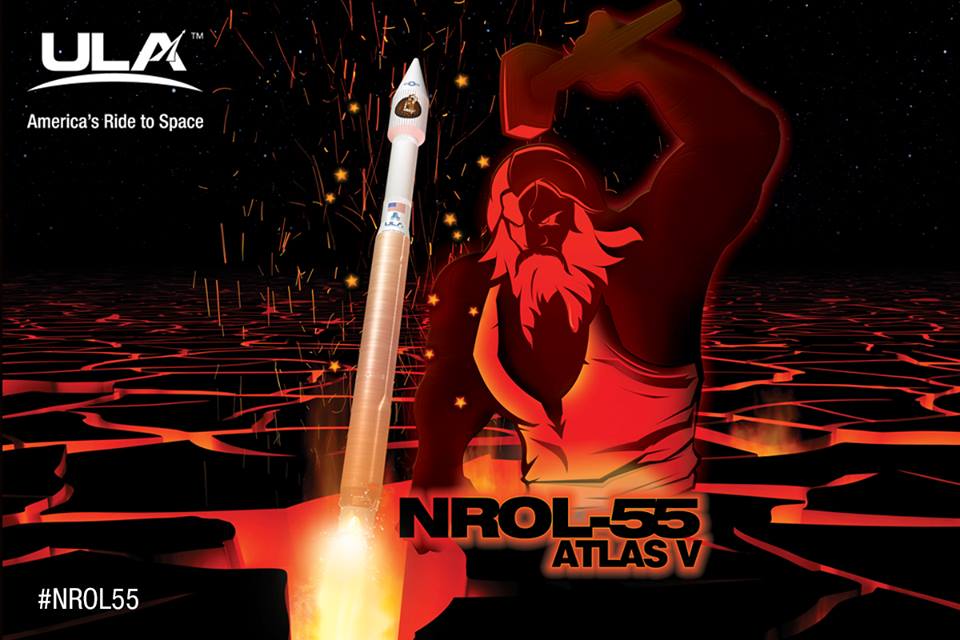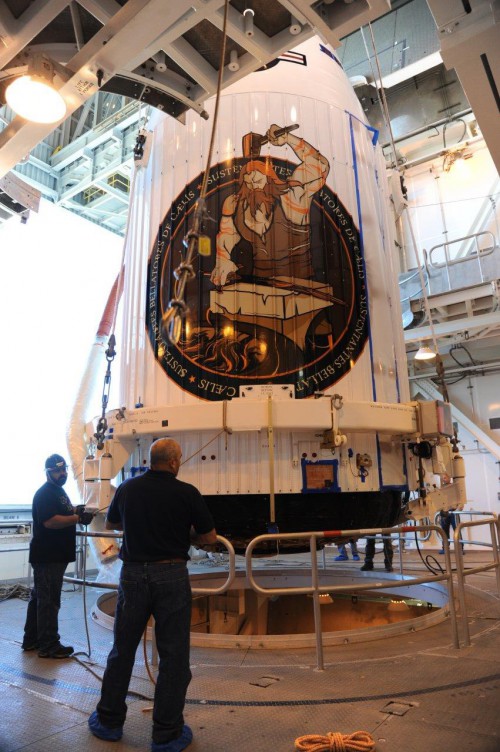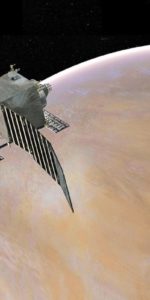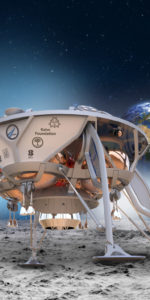
Two secret National Reconnaissance Office/U.S. Navy ocean surveillance satellites are set for launch from Vandenberg Air Force Base, Ca. Oct. 8 on the NRO-55 flight that will also deploy 13 advanced technology CubeSats.
The military space mission is planned for liftoff from Space Launch Complex-3E at 5:49 a.m. PDT (8:49 a.m. EDT) on a United Launch Alliance (ULA) Atlas-V 401 launch vehicle with no solid rocket boosters. The launch window is expected to run until 6:30 a.m. PDT.

Bookmark our “NROL-55 Launch Tracker” for regular updates and LIVE COVERAGE on Oct. 8 beginning at 5:29 a.m. PDT.
As with all NRO Atlas-V flights the highly classified intelligence payload will be propelled to orbit by an 860,000 lb. thrust Russian Energomash RD-180 engine, which continues to raise concern within the Air Force and Atlas-V users like the NRO.
The flight is also carrying 9 NRO and 4 NASA CubeSats mounted in a deployment box on the aft end of the Centaur upper stage.
The 15 satellites in total will be deployed into a 1,000 x 1,200 km. (621 x 745) mile orbit, inclined 63.4 degrees to the equator.
The two NRO satellites weigh nearly 4 tons each.
The mission is to replace two similar National Ocean Surveillance System (NOSS) spacecraft launched from Cape Canaveral on Feb 3, 2005 on the final Atlas-III rocket before the shift to the Atlas-V Evolved Expendable Launch Vehicle (EELV).
The first generation of U.S. Naval Research Center NOSS satellites were launched in groups of three starting in 1976, according to Ted Molczan, an expert Canadian astrodynamist. A second generation of triple spacecraft missions was active during the 80s and 90s, followed in 2001 by the start of third generation spacecraft launch in pairs instead of triplets, said Molczan.
The pairs of NOSS satellites fly in a “space combat spread” type formation dozens of miles apart laterally and with the second satellite in trail of the first. This is so radio transmissions from ships reach the satellites at different times enabling a constant track of a ship’s direction and speed. It allows the Navy’s top secret ship tracking intelligence center to track the position and intentions of ships of every nationality around the globe.
The NRO/NASA CubeSats are being flown on NRO-55 under the Government Rideshare Advanced Concepts (GRACE) experiment, which on this mission involves 9 NRO and 4 NASA advanced technology satellites.
They are all mounted in a Naval Post Graduate School deployment box mounted to the aft bulkhead of the rocket’s Centaur upper stage.
The NRO CubeSats are:
– AeroCube-5C and AeroCube-7: Developed by the Aerospace Corp., these two 3 lb. satellites will demonstrate tracking technologies, optical communications and laser communications.
– SNaP-3: Developed by the Army Space and Missile Defense Center involves three CubeSats each nearly 10 lb. in mass. They are to develop user-software defined radios to provide line of sight communications for disadvantage users in remote areas.
– PropCube: Developed by Tyvak Nano Satellite Systems LLC, the two 2 lb. CubeSats will perform dual frequency ionospheric calibration measurements.
– SINOD-D: Developed by SRI, the two 4.5 lb. CubeSats will demonstrate software defined radio communications.

The NASA sponsored CubeSats are:
– ARC-1: The 2.2 lb. Alaska Research CubeSat-1, developed by the University of Alaska, Fairbanks, will measure its own thermal and vibration environment during launch and also increase the technology readiness level on its attitude control determination system, as well as its high bandwidth communications system.
– BisonSat: Under development for 4 yrs. at Montana’s Salish Kootenai College on the Flathead Indian Reservation, the 2.2 lb. satellite has been training students on the design, construction, test and operation of space hardware by using a specially designed camera to calculate land cover classification, cloud cover, and cloud height measurements.
– AMSAT Fox-1: Developed by the AMSAT Corp., the 2.2 lb. satellite has an FM amateur radio voice repeater that will provide easy portable satellite communications opportunities for amateur radio operators world wide. The satellite will also test a micro electro mechanical (MEMS) gyro and a low energy proton experiment.
– LMRST-Sat: Developed by Jet Propulsion Laboratory the 6.6 lb. Low Mass Radio Transponder Satellite will demonstrate the transponder in Earth orbit to raise its technology readiness level.
NROL-55 will be the 58th Atlas-V mission for ULA since the vehicle’s inaugural launch in 2002. The mission is ULA’s 10th of 2015 and 101st since the company was founded in December 2006.
Be sure to “Like” AmericaSpace on Facebook and follow us on Twitter: @AmericaSpace
.
Missions » NROL » NROL-55 »





about 5minuets after the launch we received a single sonic boom
{correction} SINOD-D was developed by SRI International
Southwest Research Institute’s short form SwRI can be easily confused with SRI, article has been updated…
“As with all NRO Atlas-V flights the highly classified intelligence payload will be propelled to orbit by an 860,000 lb. thrust Russian Energomash RD-180 engine, which continues to raise concern within the Air Force and Atlas-V users like the NRO.”
I like the RD-180. However, maybe the Air Force’s and NRO’s leaders should quit worrying, while making ineffectual and annoying noise, and playing politics. They could instead provide some leadership and actually tell folks to hustle and do something useful about replacing the RD-180 ASAP.
Replace the Atlas V’s RD-180 engine with three modern American built GU250 kerolox engines, from the Ukrainian space industry’s Yuzhnoye. Each GU250 has 551,000 pounds of thrust. Increase the Atlas V’s first stage diameter to five meters and also modify that first stage to be reusable.
These quickly doable modifications and new lift margins should result in a flexible three engined GU250 Atlas V that is even more payload capable than the RD-180 powered Atlas V.
Changing the diameter of a first stage is not all that difficult and it was done when modifying the Delta II into the Delta III.
“The first stage was also modified with a shorter but fatter kerosene fuel tank (4 meters rather than 2.4 meters diameter), to allow the new rocket to fit within the Delta 2 service tower.” From: ‘Thunder Lost – The Delta 3 Story Thirteenth in a Series Reviewing Thor Family History’ by Ed Kyle, Updated 8/29/2010 at Space Launch Report.
Increase the Delta III’s oxygen tank also to four meters and replace the RS-27A main engine with with two GU250s, each with 551,000 pounds of thrust, while using the Atlas V’s current upper stage, or the Delta IV’s current upper stage. Doing that should result in a flexible dual GU250 powered Delta III that is even more capable than the current RD-180 powered Atlas V.
Of course doing the above would result in two separate and re-engined replacement launchers for the current RD-180 Atlas V.
Eventually, AR-1 kerolox rocket engines that would be drop-in replacement engines for the GU250 could become available and increase our options in powering launchers.
A heavy launcher, with three GU250 powered Atlas V first stage cores, or three GU250 powered Delta III first stage cores, would potentially be a cost-effective replacement launcher for the expensive Delta IV Heavy.
GU250 or AR-1 kerolox rocket engines could also power highly efficient boosters for the SLS.
Will GU250 or AR-1 powered launchers and SLS kerolox boosters be developed anytime soon?
Probably not.
Why not?
Well just maybe the President doesn’t want it to happen for an ‘obvious reason’.
ULA’s re-engined Atlas V and Delta III as well as kereolox boosters on NASA’s SLS would be in direct competition with the President’s ‘political friend’s’ current and future launchers.
Leasing for twenty years the enormous Launch Pad 39A to that ‘political friend’ of the President, which effectively increased the costs and limited the launch options of the SLS and SLS/Orion beyond LEO missions is another example of the President and his ‘political friend’ putting ‘launcher monopoly’ interests ahead of the law and interests of the American taxpayer.
That ‘political friend’s’ ‘monopoly interests’ and his ‘not so reliable launcher’, and his potential future ‘politically favored and flavored’ launchers, are the ‘hungry bear’ that is hiding under the White House’s carpet and seems to have repeatedly disrupted and ‘eaten’ the full implementation of the NASA Authorization Act of 2010 (PL 111–267) of September 29, 2010.
Jim Hillhouse, on September 26, 2015, commented after the AmericaSpace article ‘NASA Makes Improvements to Orion Heat Shield With Data Gathered From EFT-1’ “As there is no superceding authorization, the 2010 Authorization Act remains in force today, providing the guidance for all subsequent and current appropriations bills.”
See also the SPACENEWS Op-ed article,‘Ukraine Working on Low-risk Rocket Engine Solution’ by Mike Bowker and John Isella on September 28, 2015.
It is unlikely that the Air Force and NRO leaders will seriously ‘go up against’ the narrow ‘monopoly interests’ of the ‘political friend’ of our President.
Procrastinating and running around in circles and claiming the ‘sky is falling’ is much easier and personally safer for leaders of the Air Force and NRO than would be providing leadership to effectively and efficiently disrupt the de facto ‘monopoly launcher interests’ of the President’s ‘political friend’.
And the noisy nonsense of ‘inside the beltway’ RD-180 politics continues.